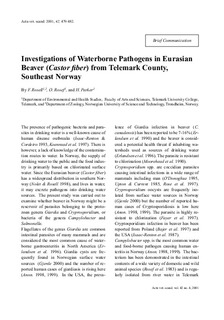| dc.contributor.author | Rosell, Frank | |
| dc.contributor.author | Rosef, Olav | |
| dc.contributor.author | Parker, Howard | |
| dc.date.accessioned | 2007-02-23T11:03:58Z | |
| dc.date.accessioned | 2017-04-19T12:25:06Z | |
| dc.date.available | 2007-02-23T11:03:58Z | |
| dc.date.available | 2017-04-19T12:25:06Z | |
| dc.date.issued | 2001 | |
| dc.identifier.citation | Acta veterinaria scandinavica | |
| dc.identifier.issn | 1751-0147 | |
| dc.identifier.uri | http://hdl.handle.net/11250/2438034 | |
| dc.description.abstract | The presence of pathogenic bacteria and parasites in drinking water is a well-known cause of human disease outbreaks. There is however, a lack of knowledge of the contamination routes to water. In Norway, the supply of drinking water to the public and the food industry is primarily based on chlorinated surface water. Since the Eurasian beaver (Castor fiber) has a widespread distribution in southern Norway, and lives in water, it may excrete pathogens into drinking water sources. The present study was carried out to examine whether beaver in Norway might be a reservoir of parasites belonging to the protozoan genera Giardia and Cryprosporidium, or bacteria of the genera Campylobacter and Salmonella. | |
| dc.format.extent | 50693 bytes | |
| dc.format.mimetype | application/pdf | |
| dc.language.iso | eng | |
| dc.publisher | Den Danske Dyrlægeforening | |
| dc.subject | Beavers | |
| dc.subject | Fresh water | |
| dc.subject | Parasitology | |
| dc.subject | Microbiology | |
| dc.subject | Pathogens | |
| dc.subject | Drinking water | |
| dc.title | Investigations of waterborne pathogens in Eurasian beaver (Castor fiber) from Telemark county, Southeast Norway | |
| dc.type | Journal article | |
| dc.type | Peer reviewed | |
| dc.subject.nsi | 484 | |
| dc.subject.nsi | 804 | |
